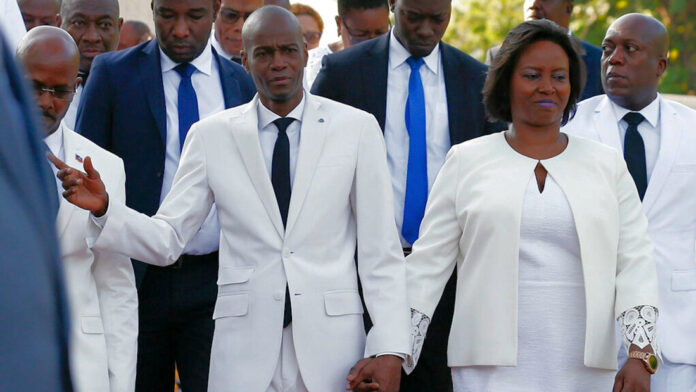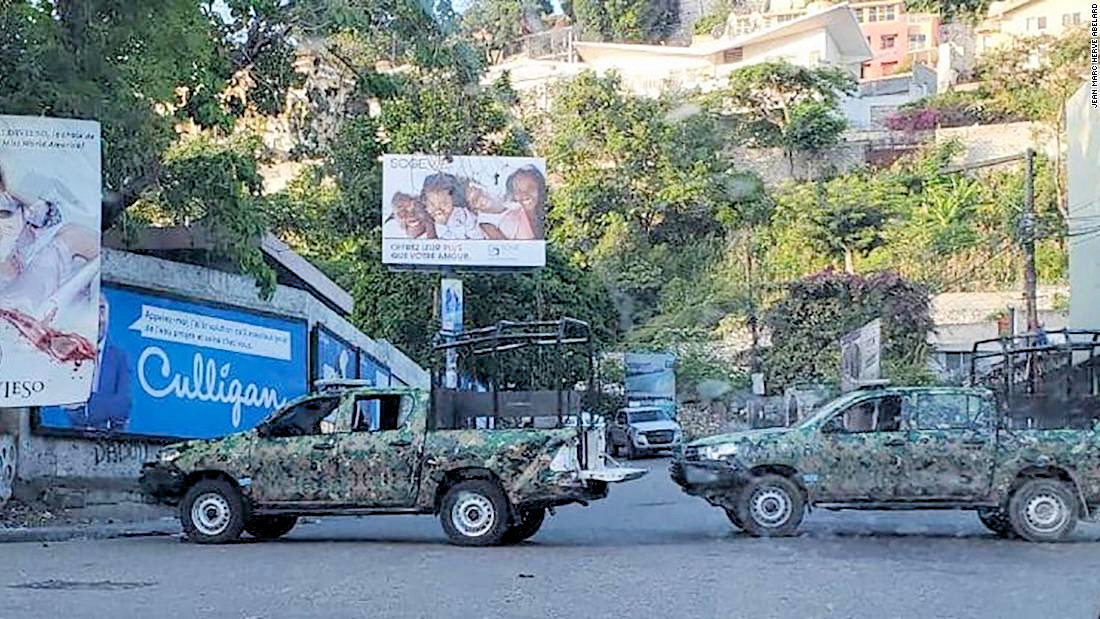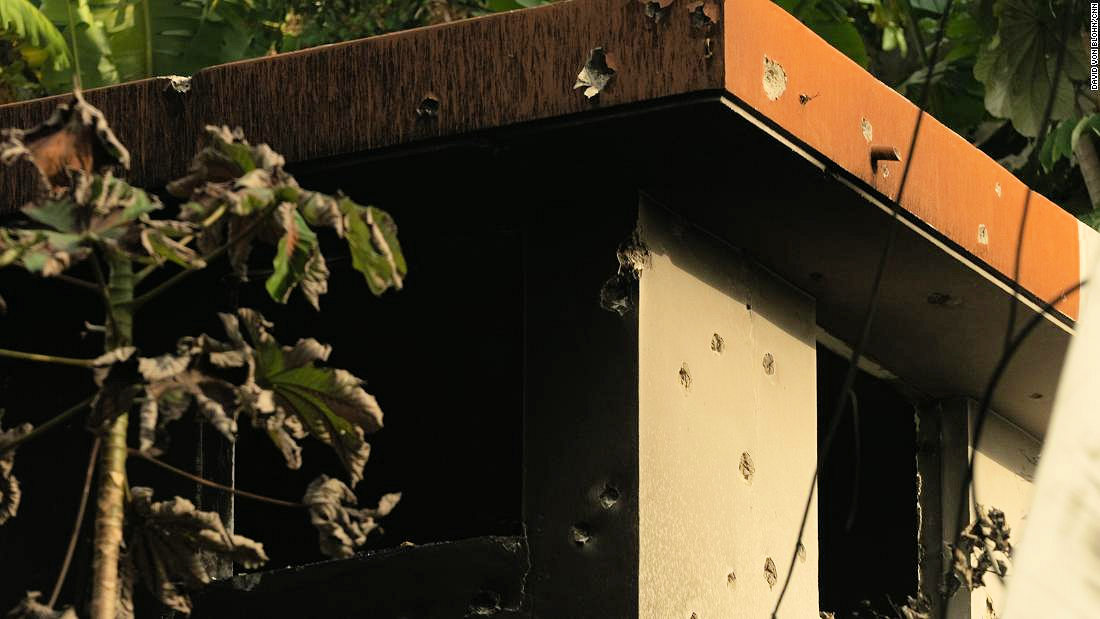
Colombian mercenaries shot to death Haitian President Jovenel Moïse with automatic weapon fire after first shooting his wife, Haïti Liberté has learned from a reliable source who spoke directly to Martine Moïse in Jackson Memorial Hospital in Miami, to which she was medevaced after the attack on the Moïse’s Pèlerin 5 home in the predawn hours of Wed., Jul. 7.
Ms. Moïse was struck by three bullets, one in an arm, and two in one leg (in the thigh and calf), our source said. Although the bullets hit no internal organs, they may have struck an artery or two because she was “losing a great deal of blood,” Ms. Moise related. She has undergone two surgeries at Jackson and was scheduled to have another on Jul. 13.
After wounding her, the Colombians turned their guns on Jovenel Moïse, who was then executed with a close-range machine-gun burst, Ms. Moïse told our source. A coroner’s report, along with forensic photos and X-rays of Jovenel’s cadaver, which have circulated on social media, appear to be consistent with this account. His corpse was riddled by 12 bullets.

The autopsy photographs and coroner’s report show that Jovenel’s left eyeball is missing. This fact has been erroneously interpreted by many as evidence of torture or ritualistic mutilation, which some analysts surmise that Haitians (possibly members of his own security detail) performed out of hatred or mystical beliefs.
Even interim Prime Minister Claude Joseph said that Jovenel Moïse was “tortured” before his death.
Other trauma to Jovenel Moïse’s body, such as shattered arm and leg bones, was consistent with the damage bullets can do, according to a pathologist who reviewed the pictures and X-rays for Haïti Liberté.
Our source also verified that the audio recording released through Martine Moïse’s Twitter account was indeed genuine. Many Haitians and other analysts had doubted its authenticity.
According to a highly placed diplomatic source, the Colombians opened a safe in the house with explosives during the attack. From it, they extracted sensitive documents which Jovenel Moïse had secured there.
Before leaving, one of the Colombian mercenaries shown a flashlight on the face of Martine Moïse, she told our source. Bathed in her own blood, she continued to play dead, and the assailants left without harming her further.
The mercenaries try to escape
On Jul. 13, CNN released a report, based on a “source with knowledge of the operation,” about how the chase following the murder unfolded.
Haitian “law enforcement teams arriving on the scene in the dark hours of the morning observed a suspicious five-car convoy near the President’s home,” begins the report. “Fearing that Moise or others may be being held hostage inside, they avoided a confrontation and allowed the convoy to leave,” the report continued.
But further down the narrow, winding Kenscoff Road, hundreds of Haitian cops stood ready for a fight behind a blockade of vehicles.
“Unable to turn their cars around in the narrow road between a walled-off ravine and a steep green hillside, the convoy’s occupants fled, abandoning firearms inside their vehicles,” the report continues. “Desperate for cover, some leaped into the polluted muck of a deep roadside drainage canal; others scattered [to] the surrounding buildings on foot… The majority found shelter in an empty two-story storefront” with “thick concrete walls [which] could serve as a shield from gunfire. Still, some would not make it out alive.”

Before dawn on Jul. 7, the Haitian cops learned that Moïse was dead and that “the suspects trapped by their roadblock had at least two hostages with them, both members of the President’s guard, the National Palace General Security Unit (USGPN),” the report continues.
The cops also learned that they were facing Spanish-speaking adversaries, against whom they decided to establish a siege.
After a stand-off that lasted until 3 p.m., “Haitian forces threw three tear gas canisters into the road in front of the shop, allowing plumes of the acrid gas to spread inside,” the report continued. “Negotiating began via one of the USGPN hostages’ phones soon after that.
The first of the suspected attackers to emerge from the building were Haitian-Americans [James Solages, 35, and Vincent Joseph, 55] – one man, followed by another. The pair identified themselves as translators, according to the source. Next down the hill came the two USGPN hostages, who told Haitian security forces that dozens of people — armed with 5.56 mm assault rifles — were still inside the concrete building.”
Now knowing the size of their opponents, “a small vanguard of Haitian forces began an assault to seize the occupied storefront. According to CNN’s source, the alleged mercenaries were well-armed, and even threw a grenade at the Haitian security forces, though it did not detonate.”

In the firefight, the Haitian cops killed three of the mercenaries, but the remainder escaped up the mountain to the embassy of Taiwan, a short distance away. Taiwan’s Foreign Ministry spokeswoman told CNN that security guards said “a group of armed suspects” had entered the mostly empty embassy grounds without permission.
On Jul. 8, Taiwan allowed Haitian authorities to enter the embassy and arrest 11 of the mercenaries, with six others captured in the surrounding area, two of them by the residents of the nearby densely-packed Pétionville slum of Jalousie. At this time, five mercenaries remain on the run.
Of the 28 now known to be involved in the killing, 26 are Colombian, two are Haitian-American. Many of the Colombians were informants who had worked with the U.S. Drug Enforcement Administration (DEA) and Federal Bureau of Investigation (FBI), according to CBS News.
As a part of their investigation, Haitian police have also arrested Dr. Christian Emmanuel Sanon, a Miami-based doctor, pastor, and presidential aspirant, who had flown on a private jet to Haiti in late June. He is being presented by Haitian authorities as the “mastermind” of the assassination plot, although this is patently unlikely given that he has filed for bankruptcy, according to the Daily Mail, and the mercenary operation was very costly.
“He said he was sent by God,” Michel Plancher, a civil engineering professor at Port-au-Prince’s Quisqueya University, told the New York Times. “He was sent on a mission of God to replace Moïse.”
This leaves open the question of who actually did mastermind, commission, and finance the sophisticated operation. The FBI and Colombian government investigators are in Haiti conducting the investigation with Haitian cops.










[…] In spite of such nay-saying, which arises from just spread fields of Haiti’s usually silent political course, Philippe is actually plainly using a surge of temper, food cravings, exhaustion, and also anxiety after 2 as well as a fifty percent years of perpetual, unsuccessful agreements in deluxe hotels and resorts in between public servants in addition to Washington’s diverse emissaries to locate a course to a federal government to change that of President Jovenel Moïse, executed Jul. 7, 2021 […]
[…] Despite such nay-saying, which comes from only scattered sectors of Haiti’s mostly silent political class, Philippe is clearly riding a wave of anger, hunger, fatigue, and desperation after two and a half years of interminable, fruitless negotiations in luxury hotels between politicians along with Washington’s assorted emissaries to find a path to a government to replace that of President Jovenel Moïse, assassinated Jul. 7, 2021. […]
[…] Despite such nay-saying, which comes from only scattered sectors of Haiti’s mostly silent political class, Philippe is clearly riding a wave of anger, hunger, fatigue, and desperation after two and a half years of interminable, fruitless negotiations in luxury hotels between politicians along with Washington’s assorted emissaries to find a path to a government to replace that of President Jovenel Moïse, assassinated Jul. 7, 2021. […]
[…] Malgré ces refus, qui ne proviennent que de secteurs dispersés de la classe politique haïtienne, pour la plupart silencieuse, Philippe surfe clairement sur une vague de colère, de faim, de fatigue et de désespoir après deux ans et demi d’interminables et infructueuses négociations dans des hôtels de luxe entre hommes politiques. avec les divers émissaires de Washington pour trouver un chemin vers un gouvernement qui remplacerait celui du président Jovenel Moïse, assassiné le 7 juillet 2021. […]
[…] Jovenel Moïse’s Jul. 7, 2021 assassination, both André and Marjorie Michel would go on to become ardent supporters of Ariel Henry, while […]
[…] l’assassinat de Jovenel Moïse le 7 juillet 2021, André et Marjorie Michel sont devenus d’ardents partisans d’Ariel Henry, […]